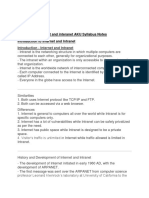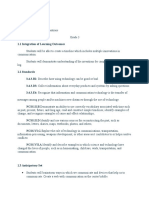0 ratings0% found this document useful (0 votes)
Fluency Report (Guiamalon)
Fluency Report (Guiamalon)
Uploaded by
Armina GuiamalonFluency refers to the smoothness and ease of spoken language production and comprehension. It is influenced by factors like stress, duration of sounds, co-articulation, and effort. There are several types of fluency, including syntactic fluency (ability to construct complex sentences), semantic fluency (ability to access a large vocabulary), pragmatic fluency (ability to respond verbally in different situations), and phonological fluency (ability to pronounce complicated sequences of sounds). Reading fluency links word recognition to comprehension through speed and accuracy of reading. Oral fluency requires both production and reception of speech, while oral reading fluency focuses on tone, rhythm, and expression during reading aloud. Written fluency can be measured by
Copyright:
© All Rights Reserved
Available Formats
Download as DOCX, PDF, TXT or read online from Scribd
Download as docx, pdf, or txt
Fluency Report (Guiamalon)
Fluency Report (Guiamalon)
Uploaded by
Armina Guiamalon0 ratings0% found this document useful (0 votes)
Fluency refers to the smoothness and ease of spoken language production and comprehension. It is influenced by factors like stress, duration of sounds, co-articulation, and effort. There are several types of fluency, including syntactic fluency (ability to construct complex sentences), semantic fluency (ability to access a large vocabulary), pragmatic fluency (ability to respond verbally in different situations), and phonological fluency (ability to pronounce complicated sequences of sounds). Reading fluency links word recognition to comprehension through speed and accuracy of reading. Oral fluency requires both production and reception of speech, while oral reading fluency focuses on tone, rhythm, and expression during reading aloud. Written fluency can be measured by
Original Title
FLUENCY REPORT (GUIAMALON)
Copyright
© © All Rights Reserved
Available Formats
DOCX, PDF, TXT or read online from Scribd
Share this document
Did you find this document useful?
Is this content inappropriate?
Fluency refers to the smoothness and ease of spoken language production and comprehension. It is influenced by factors like stress, duration of sounds, co-articulation, and effort. There are several types of fluency, including syntactic fluency (ability to construct complex sentences), semantic fluency (ability to access a large vocabulary), pragmatic fluency (ability to respond verbally in different situations), and phonological fluency (ability to pronounce complicated sequences of sounds). Reading fluency links word recognition to comprehension through speed and accuracy of reading. Oral fluency requires both production and reception of speech, while oral reading fluency focuses on tone, rhythm, and expression during reading aloud. Written fluency can be measured by
Copyright:
© All Rights Reserved
Available Formats
Download as DOCX, PDF, TXT or read online from Scribd
Download as docx, pdf, or txt
0 ratings0% found this document useful (0 votes)
Fluency Report (Guiamalon)
Fluency Report (Guiamalon)
Uploaded by
Armina GuiamalonFluency refers to the smoothness and ease of spoken language production and comprehension. It is influenced by factors like stress, duration of sounds, co-articulation, and effort. There are several types of fluency, including syntactic fluency (ability to construct complex sentences), semantic fluency (ability to access a large vocabulary), pragmatic fluency (ability to respond verbally in different situations), and phonological fluency (ability to pronounce complicated sequences of sounds). Reading fluency links word recognition to comprehension through speed and accuracy of reading. Oral fluency requires both production and reception of speech, while oral reading fluency focuses on tone, rhythm, and expression during reading aloud. Written fluency can be measured by
Copyright:
© All Rights Reserved
Available Formats
Download as DOCX, PDF, TXT or read online from Scribd
Download as docx, pdf, or txt
You are on page 1/ 5
WHAT IS FLUENCY?
The term fluency means is derived from the Latin
word “flure”- flowing, describes what the listener
perceives when listening to someone who is truly
adept at producing speech
Fluency also called volubility and eloquency- is the
property of a person or of a system that delivers
information quickly and with expertise. (Wikipedia)
Factors influences fluency are:
1)Stress which depend upon language and environment.
2)Duration of sound
3)Co articulation
4)Effort
Muscular
Mental effort
Disfluency refers to normal, non-stuttered interruptions of
speech and Dysfluency refers to stuttered interruption of
speech (Stark weather, 1987; Manning, 2001).
Fluency requires facility at a minimum of two levels of
production: language and speech.
Language fluency is one of a variety of terms used to
characterize or measure a person’s language ability, often
used in conjunction with accuracy and complexity.
Ability to produce language on demand and be understood
Varying definitions of fluency characterize it by the
language user’s automaticity their speed and
coherency of language use, or the length and rate of
their speech output.
Filmore (1979) described the three types of
language fluency, which are interpreted by Stark
Weather (1987) as syntactic, semantic and
pragmatic fluency. Stark Weather adds 4th
components which he describes as phonologic
fluency.
Syntactic fluency- speakers who are syntactically
fluent are able to construct highly complex sentences.
Semantic fluency- speakers who semantically fluent
possess and able to access large vocabularies.
Pragmatic fluency- speakers who are pragmatically
fluent are adept at a verbal response in a variety of
speaking situations.
Phonological fluency- describes those speakers who
are able to pronounce long and complicated
sequences of sounds and syllables including nonsense
and foreign words.
Speech fluency- Stark Weather (1987) discusses speech
fluency in terms of continuity, rate, duration, co
articulation and effort.
Continuity refers to speech that flows without
hesitation or stoppage. It relates to the degree to
which syllables and words are logically sequenced as
well as the presence or absence of pauses.
Rate refers to the speed in which the words are
spoken. Rate of speech also signals the perception of
fluency.
Duration of speech segments relates closely to the
co articulation of the segments. The duration of the
consonants and vowels of a language varies
considerably with speech rate and phonetic and
linguistic context
Co articulation: The co articulatory effects are
greater when the speech rate is increased (Gay,
1978) co articulatory effects contribute to the timing
and smoothness of speech.
Effort refers to the ease with which an act is
performed. Stark weather (1987) distinguishes 2
types of effort: • Effort associated with linguistic
planning (mental) • Effort associated with muscle
movement (physical) Effort can be neuromuscular in
the timing and co-ordination of respiration,
phonation, and articulation.
READING FLUENCY
Refers to the link between the recognition of words
while reading and reading comprehension, which
manifests itself in the speed and accuracy that one
is able to read text.
Research on reading fluency aligns concepts of
accuracy, automaticity and prosody.
ORAL FLUENCY OR SPEAKING FLUENCY
Is measurement both of production of and reception
of speech, as a fluent speaker must be able to
understand and respond to others in conversation.
Spoken language is typically characterized by
seemingly non fluent qualities (e.g., fragmentation,
pauses, false starts, hesitation, repetition) because of
'task stress'
ORAL READING FLUENCY
Is sometimes distinguished from oral fluency. Oral
reading fluency refers to the ability to read words
accurately and quickly while using good vocal
expression and phrasing.
Oral reading fluency is often linked to Schreiber's
Theory of Prosody, which places importance on the
tone, rhythm and expressiveness of speech.
WRITTEN OR COMPOSITIONAL FLUENCY
Can be measured in a variety of ways. Researchers
have measured by length of the composition
(especially under timed conditons,) words produced
per minute, sentence length or words per clause.
You might also like
- Chapter II The Expressive Macro Skills-Speaking100% (6)Chapter II The Expressive Macro Skills-Speaking16 pages
- Heinemann Literature: WWW - Heinemann.co - UkNo ratings yetHeinemann Literature: WWW - Heinemann.co - Uk54 pages
- The Psychology of Linguistic Form: SoundsNo ratings yetThe Psychology of Linguistic Form: Sounds15 pages
- What Pronunciation Is and Why It Matters (Pennington & Rogerson-Revell 2019)No ratings yetWhat Pronunciation Is and Why It Matters (Pennington & Rogerson-Revell 2019)12 pages
- Language 0 Communication Essential Readings NotesNo ratings yetLanguage 0 Communication Essential Readings Notes5 pages
- Linguistic Literary Terms of AccentologyNo ratings yetLinguistic Literary Terms of Accentology1 page
- The Assessment Procedures of Speaking Fluency Using Retelling TechniqueNo ratings yetThe Assessment Procedures of Speaking Fluency Using Retelling Technique8 pages
- ITLReview - Yuli Mulyati PBI III B 2042300051No ratings yetITLReview - Yuli Mulyati PBI III B 20423000516 pages
- Lesson 5 - Verbal Language in CommunicationNo ratings yetLesson 5 - Verbal Language in Communication12 pages
- Language Production and Speech Error: ObjectivesNo ratings yetLanguage Production and Speech Error: Objectives12 pages
- English Vocabulary and Meaning (Introduction)No ratings yetEnglish Vocabulary and Meaning (Introduction)20 pages
- Describing The English Language A. Language in UseNo ratings yetDescribing The English Language A. Language in Use7 pages
- Course Requirement in Stylistics (Guiamalon)No ratings yetCourse Requirement in Stylistics (Guiamalon)10 pages
- Guiamalon - Task 9 (Assessment in Learning 2)No ratings yetGuiamalon - Task 9 (Assessment in Learning 2)11 pages
- Manual in The Teaching and Assessment of Literature Studies (ENG 358)100% (1)Manual in The Teaching and Assessment of Literature Studies (ENG 358)17 pages
- Topic: Philippine Literature and Its Time Frames Focusing On ItsNo ratings yetTopic: Philippine Literature and Its Time Frames Focusing On Its4 pages
- Reflection Journal Assignment: PSY 101 Name: Jordan Carroll Reflection# 4No ratings yetReflection Journal Assignment: PSY 101 Name: Jordan Carroll Reflection# 43 pages
- Media and Information Literacy: Quarter 3 - Module 2, Week 2100% (1)Media and Information Literacy: Quarter 3 - Module 2, Week 219 pages
- Internet and Interanet Engineering NotesNo ratings yetInternet and Interanet Engineering Notes59 pages
- Eureka Forbes - The Direct Marketing Pioneer: IBS HyderabadNo ratings yetEureka Forbes - The Direct Marketing Pioneer: IBS Hyderabad20 pages
- How To Prepare For The PMP® Certification ExamNo ratings yetHow To Prepare For The PMP® Certification Exam5 pages
- Weekly Home Learning Plan Oral Communication in Context Grade 11-Week 1-Quarter 1No ratings yetWeekly Home Learning Plan Oral Communication in Context Grade 11-Week 1-Quarter 11 page
- What Pronunciation Is and Why It Matters (Pennington & Rogerson-Revell 2019)What Pronunciation Is and Why It Matters (Pennington & Rogerson-Revell 2019)
- The Assessment Procedures of Speaking Fluency Using Retelling TechniqueThe Assessment Procedures of Speaking Fluency Using Retelling Technique
- Describing The English Language A. Language in UseDescribing The English Language A. Language in Use
- Phonetics and Phonology: Sound Patterns in LanguageFrom EverandPhonetics and Phonology: Sound Patterns in Language
- Words, Phrases, and Building a Strong VocabularyFrom EverandWords, Phrases, and Building a Strong Vocabulary
- Manual in The Teaching and Assessment of Literature Studies (ENG 358)Manual in The Teaching and Assessment of Literature Studies (ENG 358)
- Topic: Philippine Literature and Its Time Frames Focusing On ItsTopic: Philippine Literature and Its Time Frames Focusing On Its
- Reflection Journal Assignment: PSY 101 Name: Jordan Carroll Reflection# 4Reflection Journal Assignment: PSY 101 Name: Jordan Carroll Reflection# 4
- Media and Information Literacy: Quarter 3 - Module 2, Week 2Media and Information Literacy: Quarter 3 - Module 2, Week 2
- Eureka Forbes - The Direct Marketing Pioneer: IBS HyderabadEureka Forbes - The Direct Marketing Pioneer: IBS Hyderabad
- Weekly Home Learning Plan Oral Communication in Context Grade 11-Week 1-Quarter 1Weekly Home Learning Plan Oral Communication in Context Grade 11-Week 1-Quarter 1







































































































